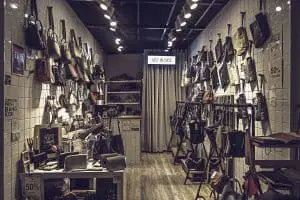Introduction
What is a brand? As for many other elements of business, it might be easier to clarify what a brand is not.
- A brand is not a logo. A logo is a tool that identifies the brand, but it is not the brand.
- A brand is not a product. Sometimes we talk about brands as if they were different products, this is technically wrong as a brand is not the product.
- A brand is not a promise. A brand ends up serving the purpose of providing a promise of consistency, but a promise is not the brand, the brand is still something else.
So what is the brand? A brand is the gut feeling that your company is able to spark into its costumers. This gut feeling has to do with all the associations that your firm has been able to build to its brand, the stronger the associations, the stronger the brand. A brand is, therefore, the reaction that our customers have when hearing our brand, and because each reaction is unique, you will find that each customer will have a unique perception or appreciation of the brand.
From a business perspective, a brand is something that is difficult to define in exact financial terms, as it is an intangible asset that can be interpreted in a variety of ways.
In this post, we’re going to explore this concept by looking at 4 different approaches to understanding brand equity, so that you may pick the one which better fits your fashion brand.
- A brand’s value in financial terms
- A brand’s value as a means to brand extension
- A brand’s value from the customer perspective
- A brand’s value in heritage and storytelling
- Conclusions
1. A brand’s value in financial terms
From a ‘strictly financial’ perspective, a brand has a financial value, which is taken into account by managers in merger and acquisition operations. A brand in this context is associated with its ‘goodwill’ or its reputation and customer base. Goodwill is an item listed on the company’s balance sheet so that this intangible element can be accounted for in financial terms.
However, a strictly financial analysis is unable to capture the full extent of the value of a brand. The balance sheet is a document providing a snapshot of a firm’s assets and liabilities at a particular time but lacks a time dimension. This approach, therefore, provides a very static estimate of the value of a brand.
As we will discuss in the next section, brand value is more of a means to an end, rather than an end in itself. Like in many other sectors of business, focusing on the immediate monetary value of a firm is a short-sighted business strategy. A brand’s value can be used for a broad variety of purposes that allow a company to grow and expand its market.
This is what we are going to discuss next, looking at a brand’s value as a tool for a product line extension.
2. A brand’s value as a means to brand extension
This alternative perspective relates to how companies are able to use their brand value to create line extensions for their products. This approach allows us think about a brand as a more elastic tool to explore new product categories and broaden a firm’s market and potential target audience.
This element of ‘elastic branding’ can be experienced in flagship stores, where the educationaltheatrical elements of the brand typically allow to stretch a brand’s value and to test its umbrella-effect potential over a wider variety of products and services. To learn more about how this can be done, we recommend reading the article entitled Flagship stores and the future of retail where we discuss this topic in more detail.
From an operational perspective, firms use this approach to generate new revenue streams connected to untapped pockets of value. In the case of masstige products for instance, high-end luxury firms establish licensing agreements with third-party manufacturers in order to produce commodity-level products which can be sold at premium prices because of the branded label.
As much as this can be perceived as a highly profitable endeavour, there are still some risks to take into consideration.
Companies that monetise their brand too much, ‘spamming it’ over an excessive range of products will incur in brand dilution or loss of perceived brand value.
Another common risk associated with this strategy instead relates to developing line-extensions through third-party manufacturers who don’t provide the same level of quality in comparison to the core product categories produced internally to the organisation. This difference in quality, will again be likely to result in a damaging effect for the company.
This is why licensing is a very powerful, yet risky strategic tool which needs to be used with care and far-sightedness.
3. A brand’s value from the customer perspective
This is the most important element of a brand’s equity, as ultimately the value of the brand is the one connected to its market and customer audience.
In relation to its customer base, a brand needs to build strong associations, which allow customers to build an emotional attachment with it.
By reinforcing these brand associations companies are able to harvest an element of intangible uniqueness, that makes them stand out in a crowded market.
In this context being able to manage and control the relationship with customers at every point of sale (POS) has become a necessity as firms need to provide a consistent brand experience at every touchpoint.
A brand ambassador, is therefore much more than a simple sales assistant, as heshe is given the job to convey values which elevate clothing, accessories and other items to access a higher level of value while building loyalty adding their special human touch.
Fostering and retaining customer relationships is not an endeavour to be taken lightly. This is because connecting with customers at the point of sale requires brands to directly manage direct retail operations. During a shopping experience, companies are able to tap into a wide set of intangible benefits that can make the difference between a one-time client and a returning customer.
In order to directly manage their relationship with customers, fashion firms need to pursue a forward integration strategy connecting to their final customer via owned retail stores.
The degree of complexity and managerial expertise required to bring to fruition this strategy cannot be underestimated, and this is why vertical integration is a typical trait of haute couture and ready-to-wear brands.
4. A brand’s value in heritage and storytelling
In the world of luxury, value associations are often connected to the element of time. Time allows companies to create a narrative whereby a brand is personified and connected to a legacy or a heritage, that only a handful of companies can claim.
Companies which are able to develop a persuasive narrative and ‘legendary upbringing‘ are able to establish a very convincing positioning strategy. To create this storytelling effect, firms work on 4 founding elements.
- Place. Heritage and legacy start with a strong association to the place of birth of a company and its founder. The place of origin plays a country-of-origin effect which taps into the values of older societies, historical events, and old-school characters. Florence, for instance, is associated with the narrative of many fashion brands, as it’s – to some extent – the birthplace of Italian fashion.
- People. The company delivers its value not only through what they do but through the people who lead and are part of the company. The ‘people’ effect often relates to family members carrying out traditional values from generation to generation. Speaking about Florence, Salvatore Ferragamo is still owned and managed as a global family business. The family dynamic is actually a staple of many Italian companies in the fashion industry and is a point of difference in comparison to other brands which might miss a personal element in their communication strategy.
- Brand Legend. A brand will always strive to earn associations with history. A legend allows a firm to become part of something much bigger than itself rooting its foundation in events which created the paradigms of contemporary society. This is done in many cases by associating brands with historical events, or technological discoveries that revolutionised and industry. Salvatore Ferragamo came from very humble origins, but his passion craftsmanship made his name a synonym of style, elegance and comfort.
- Products. A company will be often associated with a selection of iconic, timeless products which will never go out of fashion. This allows for the creation of a space in the history of fashion, where a particular item will always deliver the uniqueness of a brand. Salvatore Ferragamo shoes are among the most popular shoes in the world of business, for their ability to conjugate a formal, with an elegant style, while providing the comfort required to wear them on a daily basis.
In order to fully leverage the appeal of heritage, companies have been developing new and innovative approaches to storytelling, for instance by creating museums. A museum is the ultimate celebration of the heritage values associated with a brand and a form a long-term value creation and consumer education. Museums, at first sight, may seem unprofitable for the bottom line, but on the contrary, they are investments which allow growing the intangible elements of luxury and prestige which associate fashion with the world of art.
5. Conclusions
In a world of fast-paced consumer goods, fashion never lets designers sleep, as they are constantly drawn to create and innovate while pursuing new strategic business objectives.
Developing a strong brand is a form of long-term financial security for a company. Through a successful branding strategy, fashion firms are able to build and maintain a set of values and associations which help the firm attract and convert customers.
As we’ve seen in this post, the value of the brand, despite its intangibility has become the most relevant asset for a company as it provides firms with a ‘currency’ which allows them to develop a strong position towards its stakeholders and an element of recognisability which allows your collection to stand above the noise of a very crowded and competitive market.
At 440 Industries we have a lot of additional resources that look into branding and strategy, take a look below to see if there is anything else you may be interested in reading. Enjoy!
If you’re interested in learning more about the Fashion Industry, don’t hesitate to take a look at our course “The Fashion Industry: Explained”. Our in-depth class covers a wide range of topics spanning from understanding fashion customers and markets to developing immersive retail experiences for your customers. Here’s a link to the course, if you use the discount code BLOG20 you can access a 20% discount. Enjoy!







